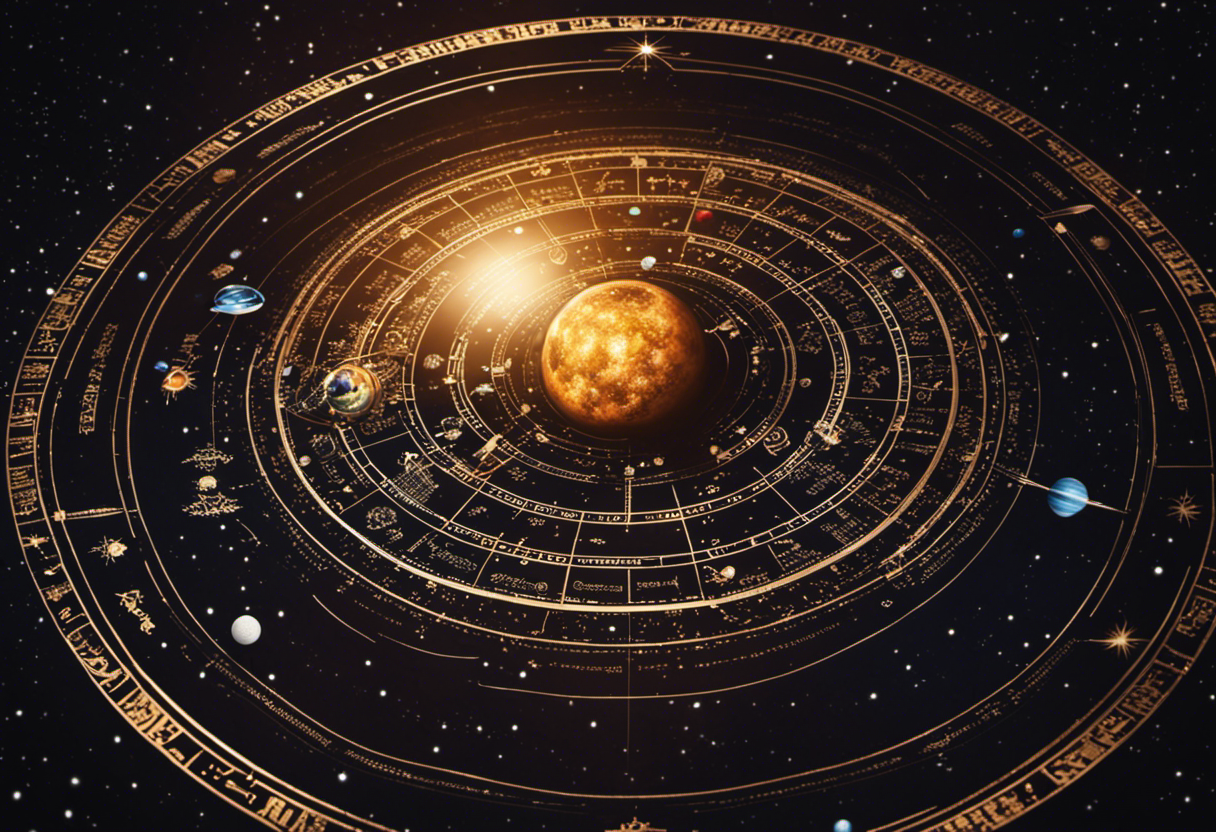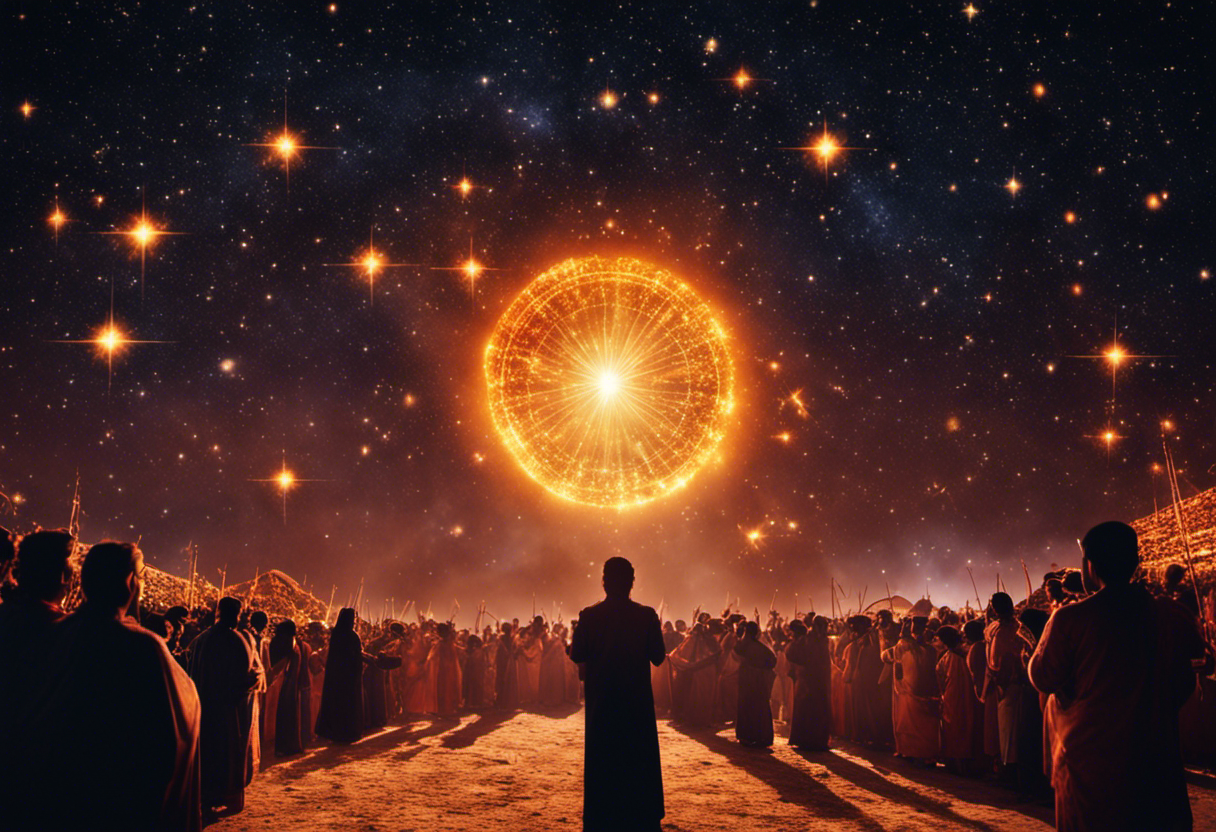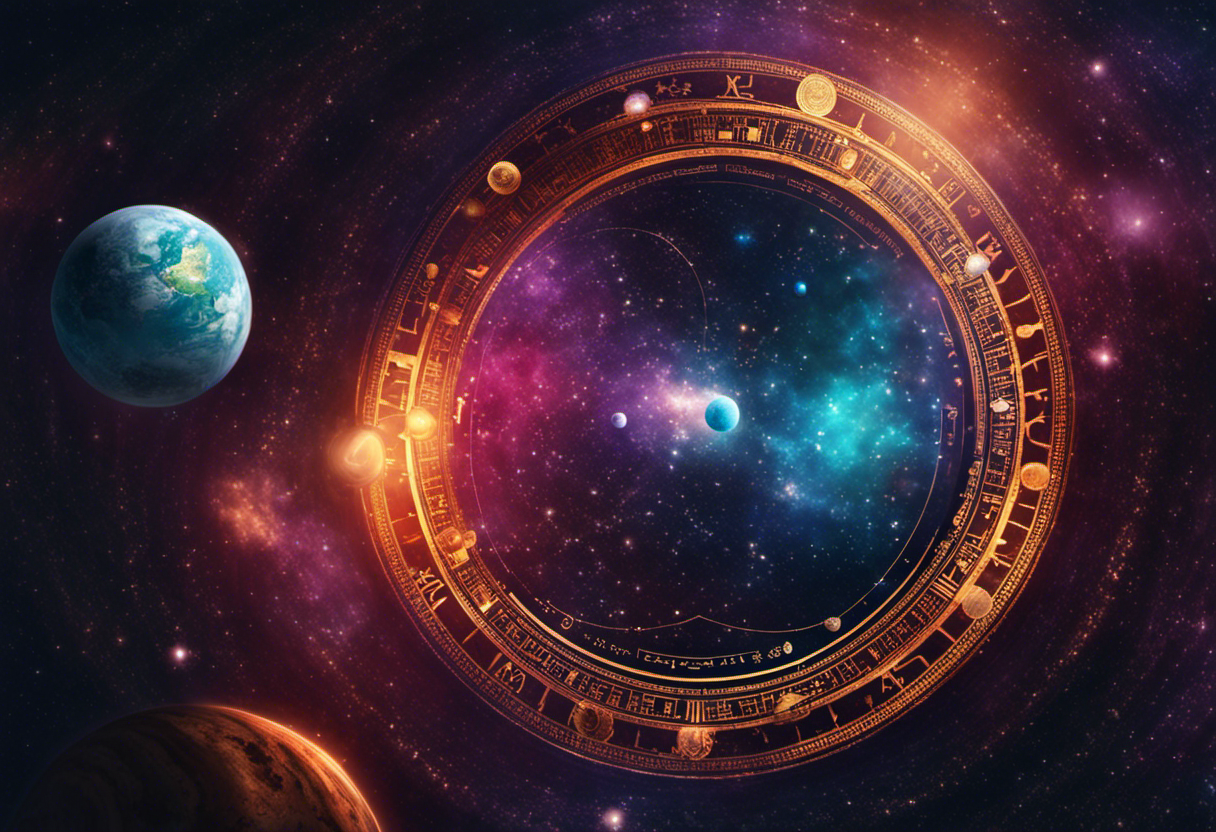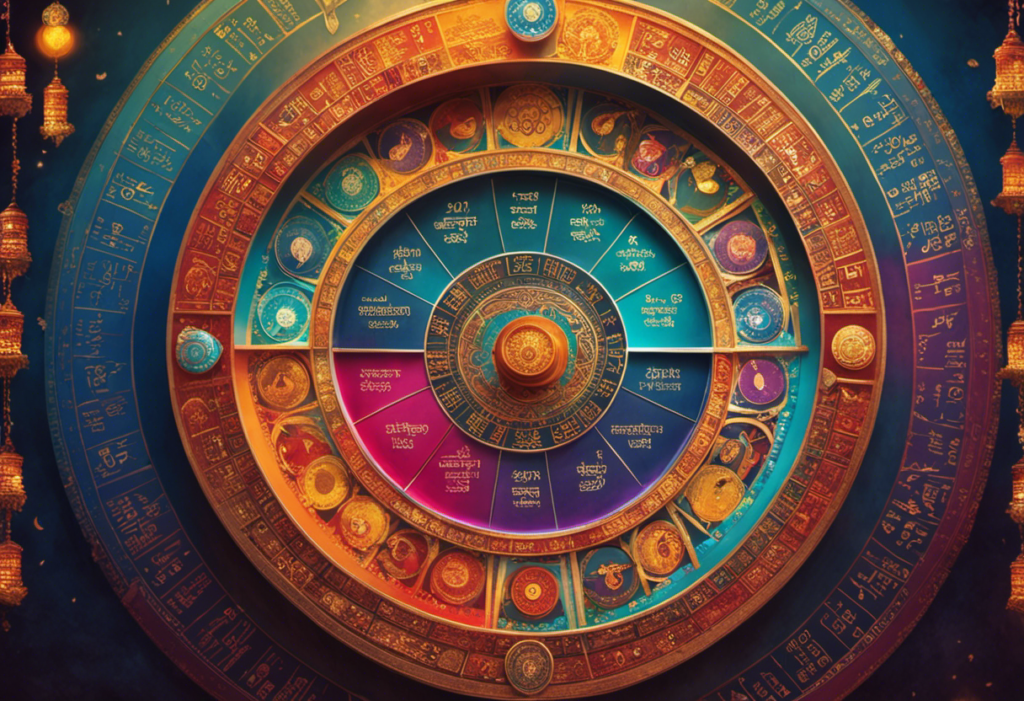In the realm of Vikram Samvat, the celestial bodies dance upon the cosmic stage, their movements orchestrating a symphony of time and destiny. This article delves into the historical significance and astrological foundations of planetary movements in Vikram Samvat.
It explores how the Sun, lunar phases, and planetary transits influence auspicious times, festivals, and religious observances. With modern applications, we unravel the intricate tapestry woven by the planets, shedding light upon the role they play in the rhythms of Vikram Samvat.
Key Takeaways
- Vikram Samvat is a historical calendar system based on the movement of the moon and the sun, with celestial influences playing a significant role in shaping events and outcomes.
- Astrological principles are intricately woven into the fabric of Vikram Samvat, with individuals making informed choices based on the position of celestial bodies.
- Planetary alignments and astrology are crucial in making predictions and providing guidance in Vikram Samvat, helping determine auspicious times and potential outcomes.
- Lunar phases and planetary movements have astrological significance in Vikram Samvat, influencing various aspects of life and providing guidance for aligning spiritual practices and making decisions.
Historical Significance of Planetary Movements in Vikram Samvat


The historical significance of planetary movements in Vikram Samvat can be observed through the records of celestial events and their impact on the cultural, religious, and agricultural practices of ancient Indian civilization.
Vikram Samvat, also known as the Vikram era, is a historical calendar system that is widely used in India. It was established by the legendary king Vikramaditya of Ujjain in 57 BCE. The calendar is primarily based on the movement of the moon and the sun, with the lunar month being the basis for its calculations.
In the historical context, the observation and interpretation of planetary movements played a crucial role in the lives of ancient Indians. The positions and alignments of celestial bodies were believed to have a direct influence on human affairs, including agriculture, religious rituals, and societal events. The ancient Indians developed a profound understanding of the celestial phenomena through meticulous observations and calculations.
Cultural traditions were deeply intertwined with the movements of the planets. The positions of the planets were believed to impact the auspiciousness of events and ceremonies. The alignment of the planets was considered a significant factor in determining the appropriate time for important occasions such as weddings, festivals, and religious rituals. Astrological predictions based on planetary movements were consulted to guide decision-making in various aspects of life.
Astrological Foundations of Vikram Samvat


The astrological foundations of Vikram Samvat are rooted in the belief that celestial influences play a significant role in shaping the events and outcomes of this calendar system.
The alignment of planets and their movements are considered crucial in determining auspicious times for various activities, such as starting new ventures or conducting religious ceremonies.
Astrology is intricately woven into the fabric of Vikram Samvat, providing a framework for individuals to make informed decisions and seek guidance based on the position of celestial bodies.
Celestial Influences on Vikram Samvat
Astrological foundations play a crucial role in understanding the celestial influences on Vikram Samvat. The Vikram Samvat calendar, which is widely used in Nepal and India, is based on the lunar cycle and incorporates astrological principles to determine auspicious dates and times for various events.
The celestial influences on Vikram Samvat are believed to have significant astrological significance, affecting various aspects of life such as agriculture, business, and personal relationships. Astrologers study the positions and movements of celestial bodies, such as the Sun, Moon, and planets, to make predictions and provide guidance based on their astrological interpretations.
These celestial influences are considered to influence the energy and vibrations surrounding important events and decisions in Vikram Samvat. By understanding and harnessing these celestial influences, individuals can make informed choices and align themselves with the cosmic energies for greater success and fulfillment.
Planetary Alignments and Vikram Samvat
One of the key elements in understanding the astrological foundations of Vikram Samvat is the role of planetary alignments. The celestial events, such as the alignment of planets, have long been believed to influence the course of human life and events.
In the context of Vikram Samvat, these alignments play a crucial role in making astrological predictions and determining auspicious times for various activities. Astrologers study the positions and movements of planets in relation to each other and to specific zodiac signs to make predictions about future events and individuals’ lives.
The planetary alignments are believed to create certain energies and influences that can affect different aspects of life, such as career, relationships, and health. By understanding and analyzing these alignments, astrologers can provide guidance and insights into the potential outcomes and challenges that individuals may face in a given Vikram Samvat year.
Astrology’s Role in Vikram Samvat
Astrology plays a significant role in Vikram Samvat. It utilizes the knowledge of planetary movements and alignments to provide insights into the auspicious times and potential outcomes for individuals in this calendar system.
The astrological predictions in Vikram Samvat are based on the positions of planets and their transits. Astrologers study the positions of the planets at the time of an individual’s birth to determine their astrological chart. These positions are crucial in understanding the individual’s personality traits, strengths, weaknesses, and potential life events.
Astrology also helps identify the most favorable times for important events such as weddings, business ventures, or religious ceremonies. By considering the planetary positions, individuals can maximize their chances of success and positive outcomes.
Furthermore, astrology provides remedies and guidance for individuals facing challenging times or negative planetary influences. These remedies can involve specific rituals, mantras, gemstone recommendations, or lifestyle changes to mitigate the negative effects and enhance positive energy.
Moreover, astrology in Vikram Samvat offers insights into future events and potential outcomes based on the planetary positions. By understanding the planetary influences, individuals can make informed decisions and take appropriate actions to navigate their lives effectively.
The Influence of the Sun in Vikram Samvat


The influence of the Sun in Vikram Samvat can be observed through its impact on the various aspects of life and the changes it brings about in the celestial and earthly realms. The Sun plays a significant role in Vikram Samvat, the Hindu calendar system, as it is considered the primary source of energy and life on Earth.
One of the main ways in which the Sun influences Vikram Samvat is through its solar cycles. These cycles, which last approximately 11 years, have a direct impact on various phenomena such as climate patterns, agricultural productivity, and overall human well-being. The different phases of these cycles, characterized by variations in solar activity and sunspot numbers, can affect everything from rainfall patterns to the prevalence of certain diseases.
Solar eclipses also hold great significance in Vikram Samvat. These celestial events occur when the Moon passes between the Earth and the Sun, temporarily blocking the Sun’s light. In Hindu mythology, solar eclipses are often seen as powerful moments for spiritual practices and rituals. They are believed to have the potential to cleanse negative energies and bring about positive transformations.
Lunar Phases and Vikram Samvat


The lunar phases play a significant role in Vikram Samvat, the Hindu calendar system.
The lunar calendar is based on the cycles and phases of the moon, which have a profound astrological impact on Vikram Samvat.
The different lunar phases are believed to influence various aspects of life, including agriculture, festivals, and religious ceremonies.
Lunar Calendar Significance
As we delve into the significance of the lunar calendar in relation to Vikram Samvat, it is important to understand the influence of lunar phases on this ancient Hindu calendar system.
The lunar calendar, known as the tithi system, plays a vital role in determining the dates of religious observances and festivals in the Hindu tradition. Here are four key ways in which lunar phases impact Vikram Samvat:
- Calculation of Months: The Vikram Samvat calendar follows a lunar month, which begins with the new moon and ends with the next new moon. Each month is divided into two fortnights, known as the Shukla Paksha (waxing phase) and the Krishna Paksha (waning phase).
- Festivals and Auspicious Days: The lunar calendar helps in determining the dates for major Hindu festivals and auspicious days, such as Diwali, Holi, and Navratri. These celebrations are often aligned with specific lunar phases, such as the full moon or new moon.
- Astrological Significance: Lunar phases are considered important in astrology and are believed to influence various aspects of life. The Vikram Samvat calendar takes into account the position of the moon in determining auspicious timings for important events and ceremonies.
- Spiritual Practices: Many religious observances, such as fasting and offering prayers, are linked to specific lunar phases. The Vikram Samvat calendar provides guidance for individuals to align their spiritual practices with the lunar cycles for enhanced spiritual growth and well-being.
Astrological Impact on Vikram Samvat
Astrological predictions and influences play a significant role in shaping the events and outcomes within the ancient Hindu calendar system of Vikram Samvat. Particularly in relation to the lunar phases.
The lunar phases hold immense importance in Vikram Samvat, as they are believed to affect various aspects of life, including agriculture, business, and personal relationships.
Astrological predictions are based on the positions and movements of celestial bodies, which are recorded in astrological charts. These charts provide valuable insights into the influence of planetary movements on Vikram Samvat.
By analyzing these charts, astrologers can make predictions about the impact of lunar phases on different areas of life, allowing individuals to plan their activities accordingly.
The astrological impact on Vikram Samvat highlights the interconnectedness between the celestial and earthly realms, providing a framework for understanding and navigating life’s challenges and opportunities.
Planetary Transits and Auspicious Times in Vikram Samvat


Discussing the significance of planetary transits and auspicious times in Vikram Samvat, we can observe the influence of celestial movements on various aspects of life. The planetary positions and their transits play a crucial role in determining the auspicious timings for important events and activities in Vikram Samvat.
Here are four key points to understand the connection between planetary transits and auspicious times in Vikram Samvat:
- Planetary Alignments: The positions of planets in the sky at a particular time can affect the overall energy and atmosphere. Certain alignments, such as the conjunction or opposition of planets, are considered auspicious and are believed to bring positive outcomes.
- Auspicious Yogas: Yogas are specific combinations of planetary positions that are believed to create favorable conditions. For example, the presence of the ‘Gajakesari Yoga’ (Moon-Jupiter conjunction) is considered highly auspicious and is believed to bring success, prosperity, and wisdom.
- Muhurat Selection: Muhurat refers to the auspicious time period during which certain activities or events should be initiated. Astrologers analyze the planetary transits to determine the most favorable muhurat for important occasions like weddings, housewarming ceremonies, or business ventures.
- Personal Astrology: Individual horoscopes are analyzed to identify the favorable planetary positions for an individual. Auspicious days and timings are then suggested based on the person’s birth chart to maximize positive outcomes and minimize any potential challenges.
Festivals and Religious Observances Aligned With Planetary Movements in Vikram Samvat


Several festivals and religious observances are aligned with planetary movements in Vikram Samvat, highlighting the deep connection between celestial events and the cultural and spiritual practices of this ancient calendar system. Throughout the year, various festivals and religious observances are celebrated based on the positions of the planets and their influences on human lives.
One such festival is Diwali, also known as the Festival of Lights. Diwali is celebrated on the new moon day of the Hindu month of Kartik, which typically falls between October and November. This auspicious festival marks the return of Lord Rama after his victory over the demon king Ravana. The planetary alignment during Diwali is believed to enhance the positive energies and bring prosperity and happiness to individuals and their families.
Another significant festival aligned with planetary movements is Navratri, a nine-night celebration dedicated to the worship of Goddess Durga. Navratri is celebrated twice a year, during the months of Chaitra and Ashwin, which correspond to the spring and autumn seasons. The festival begins on the first day of the waxing moon in the month of Chaitra and ends on the tenth day, known as Dussehra. The alignment of the planets during Navratri is believed to amplify the divine energies and provide devotees with spiritual upliftment and protection.
Furthermore, the festival of Makar Sankranti is celebrated on the day when the Sun transitions into the zodiac sign of Capricorn. This festival marks the end of winter and the beginning of longer days. The planetary alignment during Makar Sankranti is believed to bring positive energy and prosperity to individuals.
Religious observances such as fasting and performing rituals are also influenced by planetary movements in Vikram Samvat. For example, certain fasts are observed on specific days of the week, corresponding to the ruling planet of that day. It is believed that fasting on these days can appease the ruling planet and bring about positive effects in one’s life.
Modern Applications of Planetary Movements in Vikram Samvat


The advancements in technology have allowed for the integration of planetary movements in various fields, including finance, agriculture, and personal well-being, in the modern applications of Vikram Samvat. With the understanding that celestial events can have an impact on various aspects of life, people have started using the knowledge of planetary movements to their advantage.
Here are four modern applications of planetary movements in Vikram Samvat:
- Financial astrology: Traders and investors have started incorporating planetary movements into their decision-making process. By analyzing the position of planets and their aspects, financial astrologers predict market trends and make investment recommendations.
- Agricultural planning: Farmers are using planetary movements to optimize their agricultural practices. They consider the positioning of celestial bodies to determine the best time for sowing seeds, harvesting crops, and even applying fertilizers. This helps improve crop yield and overall agricultural productivity.
- Astrological counseling: Individuals seek astrological guidance to gain insights into their lives. Astrologers analyze planetary positions to provide advice on various aspects, such as career, relationships, and health. This can help individuals make informed decisions and navigate through life’s challenges.
- Personal well-being: Many people believe that planetary movements can influence their physical and mental well-being. They consult astrologers to understand the potential impact of celestial events on their health and use this information to take preventive measures or seek appropriate medical treatments.
The modern applications of planetary movements in Vikram Samvat demonstrate that this ancient system is still relevant and valuable in today’s world. By leveraging the knowledge of celestial events, individuals and industries can make more informed choices and improve various aspects of their lives.
Conclusion
In conclusion, the role of planetary movements in Vikram Samvat holds significant historical and astrological importance.
The alignment of lunar phases, planetary transits, and auspicious times play a crucial role in determining festivals and religious observances in this ancient calendar system.
Furthermore, the modern applications of planetary movements in Vikram Samvat continue to be studied and utilized for their potential insights and guidance.
One wonders, can understanding and harnessing these celestial influences enhance our understanding of time and our place in the universe?




